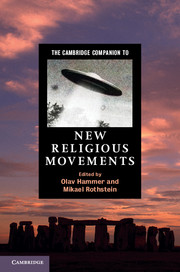Book contents
- Frontmatter
- Introduction to new religious movements
- Part I Social science perspectives
- Part II Themes
- 4 History and the end of time in new religions
- 5 Charismatic leaders in new religions
- 6 Rituals in new religions
- 7 Canonical and extracanonical texts in new religions
- Part III New religious movements
- Index
- Other titles in the series
7 - Canonical and extracanonical texts in new religions
from Part II - Themes
Published online by Cambridge University Press: 28 September 2012
- Frontmatter
- Introduction to new religious movements
- Part I Social science perspectives
- Part II Themes
- 4 History and the end of time in new religions
- 5 Charismatic leaders in new religions
- 6 Rituals in new religions
- 7 Canonical and extracanonical texts in new religions
- Part III New religious movements
- Index
- Other titles in the series
Summary
INTRODUCING THE THEME
Texts devoted to religious matters can be categorized in various ways. One common way of doing so is to divide the corpus according to genre. The terminology of religious genres is extensive and includes categories such as myth, legend, creed, homily, apology, hagiography, commentary, eschatology, theological tract, hymn, psalm, and prayer. Founders of and spokespersons for new religions have produced all of these well-known types, confirming one of the main points made in the Introduction to this volume: there is nothing extraordinary or strange about new religions.
A cross-cutting distinction of more immediate concern in the present context is based on the status accorded the writings within a given religious tradition. Most if not all traditions have selected a small sub-set of writings as being particularly sacred, effectively creating a canon. Thus, Hindu texts are divided according to status ranking the direct revelations from the divine – shruti – highest, while the recollections of sages since the dawn of time, the smriti, occupy a secondary position. And of course, Christian, Jewish, and Islamic traditions also set certain texts (Bible, Tanakh, Qur'ān) apart as canonical. Some religions go further and distinguish several levels of sacredness. Mahayana Buddhism grants canonical status to a large corpus of works, but suggests that certain texts present religious truth in its highest form, while others are formulated in a manner appropriate to the spiritually less astute, because the Buddha was a master at deploying skillful didactic means.
- Type
- Chapter
- Information
- The Cambridge Companion to New Religious Movements , pp. 113 - 130Publisher: Cambridge University PressPrint publication year: 2012
- 3
- Cited by

